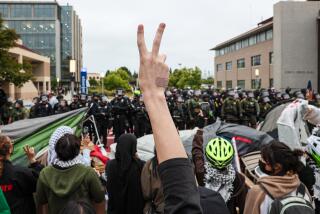CSUN May See Rush of Retirements
NORTHRIDGE ā Forty years after its founding, Cal State Northridge is bracing for an exodus of nearly half its faculty members over the next decade--just as student enrollment surges.
Administrators and other campus leaders say the retirements will deprive CSUN of some of its most fertile minds, professors with the intellectual heft of a lifetime of scholarship.
But, they add, retiring faculty will also provide CSUN with the chance to breathe new life into its academic programs. Indeed, many universities rely on retirements to make way for newcomers armed with the latest theories and prepared to take old disciplines into bold new directions.
āAssuming that most faculty chose to retire at about the age of 63 to 65, we would expect that about half will retire by the end of the next decade,ā said John B. Mason, CSUNās associate vice president for faculty affairs. āBut I want to stress that retirement is not mandatory and that the university wants to keep our faculty as long as they are interested in pursuing their careers and actively pursuing them.ā
One-third of CSUNās professors will be over the age of 60 next school year, but national studies suggest that even after the federal government eliminated mandatory retirement for academics in 1994, most continue to retire before 65.
The possibility of so many retirements in so short a time has given added urgency to CSUNās hiring process--a process that was dormant during the mid-1990s.
āThe number of tenured and tenure-track needs to grow, and we have a plan,ā Mason said. āHiring faculty is one of the most important things a university does. It demands a great deal of time for many people: hundreds of person-hours for each hire. Thereās also nothing as exciting for a university.ā
Last year, CSUN began its biggest faculty hiring binge in a decade, filling 40 full-time positions. This year, money has been allotted for 70 professors, though only a third have been hired so far.
But CSUN must continue hiring professors to ameliorate years of attrition and accommodate rising student enrollment, administrators say. With 27,000 students, CSUNās enrollment is expected to grow dramatically over the next few years. And after last yearās three dozen hires, CSUN has only 784 tenured and tenure-track faculty, including 86 who are teaching half time in an early retirement program. In 1993, CSUN had 815 professors.
āThe bottom line is that we have fewer tenured and tenure-track faculty but are beginning to rebuild our numbers,ā Mason said. āWeāre still working on hiring plans for next year, but it looks like weāll be hiring 50 to 60 faculty members in tenure-track positions. This will cover attrition, enrollment growth. . . . Our hope is that we can maintain that pattern for each of the next five years.ā
In addition to meeting rising enrollment, campus leaders hope to reduce CSUNās reliance on non-tenure track and part-time workers. But critics worry that CSUNās current hiring plans, general as they are, may not go far enough. They fear a repeat of the mid-1990s, when CSUNās hiring did not keep pace with retirement or enrollment and part-time lecturers were hired as a stop-gap measure.
āThat kind of hiring ultimately undermines the quality of a CSUN education,ā said Edda Spielmann, a professor and president of CSUNās faculty union.
When CSUN was founded in 1958--during the last major expansion of American higher education--California educational leaders found themselves scrambling to find enough qualified instructors to teach the baby boom generation.
These days, graduate schools produce more professors than there are teaching posts. And with the economy flying high and federal and state politicians more willing to increase education spending, university officials are confident they will have the resources to replace rapidly retiring professors.
One opening in CSUNās English department, for example, attracted 240 job applications.
āPersonally, I donāt think thereās a crisis on the horizon,ā said Sam Strafaci, director of Human Resources for California State University. Systemwide, CSU funded 460 new tenure-track positions last fall--the largest number of openings since 1990. āSupply and demand indicate that our recruitment efforts will be successful.ā
But with so many academics in the market and an imminent student population boom on the horizon, some say conditions will be ripe for more temporary hires at CSUN.
California educators estimate that by 2005, more than 455,000 additional students will be entering Californiaās higher educational system.
At the same time āmore people are retiring earlier than they used to,ā said Brett Hammond, a senior researcher at TIAA-CREF, the worldās largest faculty pension organization. āNow thereās a big push to retire at 60 or 62.ā
Claremont Graduate University professor Jack Schuster, a national expert on higher education says: āWeāre in the process of redefining what constitutes an academic career.ā Schuster argues that with more mobile, temporary workers, academic jobs are taking on many attributes of jobs in the wider economy, he said.
Faculty retirements could speed this process.
āWeāve had people fully qualified for full-time work hired on as itinerant labor for decades,ā Spielmann said. āThat is not the way to create the best education for the students coming in. That is a danger.ā
During Californiaās recession earlier this decade, CSUN and other state universities relied heavily on part-time teachers. As recently as last year, nearly half of CSUNās teachers worked part time. This year, the figure is about 40% and if current hiring trends continue, that percentage could continue to drop.
āOne of the things we discovered over the past few years is that itās not healthy to rely too much on part-timers,ā said Albert Kinderman, president of the Faculty Senate. Kinderman said he was heartened by the recent hires and optimistic about CSUNās future.
Still, looming retirements concern Kinderman, who said CSUN has trouble attracting top-flight faculty in some instances.
āIn some areas it has been difficult to attract some people with our salaries,ā he said. The California Faculty Assn., the stateās largest professors union, maintains that CSU professors typically earn 11% less than their counterparts at comparable universities.
According to CSUNās annual hiring survey, the campus often gets its first choice of job candidates, Mason said.
But Mason agreed that money is an issue, citing a 1998 CSUN hiring survey that found most professors who declined CSUN job offers did so because they thought salary offers were too low.
More to Read
Sign up for Essential California
The most important California stories and recommendations in your inbox every morning.
You may occasionally receive promotional content from the Los Angeles Times.










